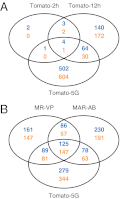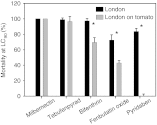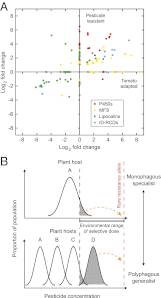A link between host plant adaptation and pesticide resistance in the polyphagous spider mite Tetranychus urticae
- PMID: 23248300
- PMCID: PMC3545796
- DOI: 10.1073/pnas.1213214110
A link between host plant adaptation and pesticide resistance in the polyphagous spider mite Tetranychus urticae
Abstract
Plants produce a wide range of allelochemicals to defend against herbivore attack, and generalist herbivores have evolved mechanisms to avoid, sequester, or detoxify a broad spectrum of natural defense compounds. Successful arthropod pests have also developed resistance to diverse classes of pesticides and this adaptation is of critical importance to agriculture. To test whether mechanisms to overcome plant defenses predispose the development of pesticide resistance, we examined adaptation of the generalist two-spotted spider mite, Tetranychus urticae, to host plant transfer and pesticides. T. urticae is an extreme polyphagous pest with more than 1,100 documented hosts and has an extraordinary ability to develop pesticide resistance. When mites from a pesticide-susceptible strain propagated on bean were adapted to a challenging host (tomato), transcriptional responses increased over time with ~7.5% of genes differentially expressed after five generations. Whereas many genes with altered expression belonged to known detoxification families (like P450 monooxygenases), new gene families not previously associated with detoxification in other herbivores showed a striking response, including ring-splitting dioxygenase genes acquired by horizontal gene transfer. Strikingly, transcriptional profiles of tomato-adapted mites resembled those of multipesticide-resistant strains, and adaptation to tomato decreased the susceptibility to unrelated pesticide classes. Our findings suggest key roles for both an expanded environmental response gene repertoire and transcriptional regulation in the life history of generalist herbivores. They also support a model whereby selection for the ability to mount a broad response to the diverse defense chemistry of plants predisposes the evolution of pesticide resistance in generalists.
Conflict of interest statement
The authors declare no conflict of interest.
Figures





References
-
- Strong DR, Lawton JH, Southwood TRE. Insects on Plants: Community Patterns and Mechanisms. Oxford: Blackwell Scientific; 1984.
-
- Bernays EA, Chapman RF. Host-Plant Selection by Phytophagous Insects. New York: Chapman & Hall; 1994.
-
- Cornell HV, Hawkins BA. Herbivore responses to plant secondary compounds: A test of phytochemical coevolution theory. Am Nat. 2003;161(4):507–522. - PubMed
-
- Berenbaum MR, Favret C, Schuler MA. On defining key innovations in an adaptive radiation - cytochrome P450s and Papilionidae. Am Nat. 1996;148:S139–S155.
Publication types
MeSH terms
Substances
Associated data
- Actions
- Actions
- Actions
- Actions
- Actions
- Actions
LinkOut - more resources
Full Text Sources
Molecular Biology Databases

